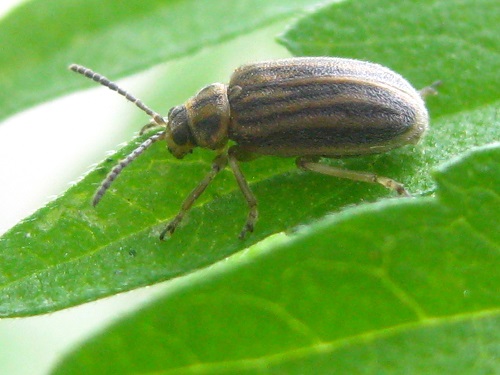Larger males facilitate population expansion in Ophraella communa
Yan Zhang, Chenchen Zhao, Weihua Ma, Shaowei Cui, Hongsong Chen, Chao Ma, Jianying Guo, Fanghao Wan, Zhongshi Zhou

广聚萤叶甲 中国农科院植保所供图

广聚萤叶甲在交配 中国农科院植保所供图
昆虫的择偶标准是什么?
近日,《动物生态学》(Journal of Animal Ecology)在线发表的一项最新成果揭示,广聚萤叶甲雌虫择偶时偏爱大个子。
中国农业科学院植物保护研究所农业入侵生物预防与监控创新团队对昆虫的种群繁衍能力与其配偶选择的关系进行了研究。他们发现了豚草天敌广聚萤叶甲雌虫选择大体型雄虫交配的生物学意义与调控机制。
通讯作者周忠实研究员介绍,在动物界中,雌虫选择与雄虫交配通常产生一定的“繁殖与生存效益”。这项研究发现,广聚萤叶甲雌虫对配偶具有明显的选择性。在大体型雄虫和小体型雄虫同时存在的情况下,雌虫更喜欢选择大体型雄虫进行交配。
体型的大小通常影响昆虫的繁殖能力。因此,很多昆虫的雌性会根据个体大小来选择配偶。研究发现,昆虫的雌虫选择个体大的雄虫交配后,其繁殖力显著提高。不少研究认为,雄虫的精液蛋白能给雌虫卵巢发育和卵子发生提供必要的营养。
团队研究发现,雌虫选择与大体型雄虫交配时,不仅可以繁育出更多的子代,且发育过程中的子代存活率更高,种群的内禀增长率、局限增长率和净增长率亦显著升高。
经种群发展预测,选择与大体型雄虫交配的子代种群发展趋势明显加快。有意思的是,雌虫选择与大体型雄虫交配后,其子代大体型的成虫也显著增多。这说明选择大体型雄虫交配不仅可以促进雌虫的生殖,且对子代种群起到了明显的优化。
随后,基于转库组学与qPCR技术筛选得到在大体型雄虫精巢和附腺中高表达的基因OcACE、OcSFP和OcCBP。通过qPCR技术分析三个基因的表达谱,发现均在初羽化雄虫的附腺和睾丸中高表达,之后表达量趋于平稳。
进一步,在雌雄虫不同的组织的表达谱发现,3个基因在初交配结束雌虫的交配囊中表达量高于其他组织2倍以上。说明上述基因均为精液蛋白基因。
通过RNAi沉默雄虫体内三个基因后,与之交配的雌虫生殖力表现出明显下降。进一步明确了精液蛋白在成虫生殖调控与种群繁衍中发挥着非常重要的作用。
来源:中国科学报 李晨
Abstract
One of the most intriguing concepts in animal ecology is the reproductive advantages offered by larger body size, and the females prefer to mate with larger males to gain reproductive advantage.Currently, it is not clear how females recognize signs of male ‘quality’ and what mechanisms are involved in producing offspring with direct or indirect benefits. Our study aims to assess the preferences of females for males in Ophraella communa, determine the reproductive benefits and reveal the underlying mechanism behind this advantage.We demonstrate that male body size is an important determinant in the evolutionary process of O. communa, affecting female mate choice. Moreover, our study establishes that females prefer males with a larger body size, and this could further improve the developmental and reproductive fitness of their offspring. Finally, we focus on the seminal fluid proteins (SFPs) in O. communa, determine differentially expressed genes (i.e. OcACE, OcCBP and OcSFP) by analysing their proteomes and transcriptomes, and define the role of these SFPs-related genes through RNAi.Our study proved that the reproductive benefit of large males may be regulated by biased expression of crucial SFPs genes. The present study advances our understanding of the biological significance of preferential mating.






 位访客
位访客